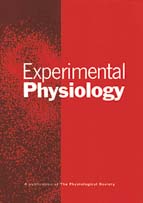Article contents
Cold exposure differentially stimulates angiogenesis in glycolytic and oxidative muscles of rats and hamsters
Published online by Cambridge University Press: 07 November 2003
Abstract
Control (normothermic) and cold-acclimated (environmental temperature gradually reduced from 20 to 5 °C for 4 weeks) groups of male rats and hamsters were compared to elucidate the nature of angiogenesis in oxidative and glycolytic muscles of these species during progressive cold exposure. Skeletal muscle capillarity and fibre cross-sectional area were measured in the tonic soleus (SOL) and phasic tibialis anterior (TA). Cryostat sections were stained for alkaline phosphatase (ALP) activity to identify all capillaries, and proliferating cell nuclear antigen (PCNA) to localise the site of cellular proliferation. Cold-induced angiogenesis, indicated by an increase in capillary to fibre ratio (C:F), occurred in SOL of rats (~20 % increase, P < 0.05) but not hamsters (~9.5 % increase, n.s.), and in TA of hamsters (~22 % increase, P < 0.01) but not rats (~1 % increase, n.s.). The change in C:F was highest in the glycolytic cortex region of TA where fibre size is larger than in the oxidative core. Capillary-specific cell proliferation (co-localised ALP and PCNA labelling) increased in parallel with C:F. The total PCNA label density within the interstitium was some 5-fold higher than that co-localised with capillaries, but where angiogenesis occurred the relative increase in capillary labelling was 2-fold greater than for other cells of the interstitium. These data suggest a significant role for endothelial cell proliferation in the angiogenic response, indicative of the sprouting form of angiogenesis. There was a tendency for fibre hypertrophy in both SOL and TA of rats, especially in the core region of TA (P < 0.01), such that capillary density (CD) and intramuscular diffusion distances (DD) were largely unchanged following cold exposure. In contrast, fibre size was maintained in hamsters, DD reduced and CD increased compared to control TA (P < 0.01). In conclusion, cold acclimation stimulated angiogenesis in muscle of hamsters more than in rats, possibly due to a higher metabolic rate in the smaller species. Angiogenesis was also seen in SOL of rat, where oxidative capacity and muscle activity is higher than the TA. Thus, a combination of oxidative capacity, muscle activity, and fibre size may determine the degree of angiogenesis in response to low environmental temperature.Experimental Physiology (2003) 88.6, 741-746.
Information
- Type
- Full Length Papers
- Information
- Copyright
- The Physiological Society 2003
- 6
- Cited by

